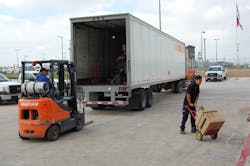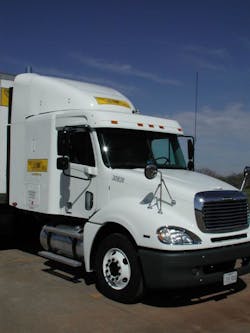AUSTIN. Supply chain pressure runs downhill, but truckload carriers have nothing to fear from e-commerce—so long as they are, for all practical purposes, perfect.
And truckers not only need to be perfect, they’re increasingly expected to reassure shippers and receivers that everything’s fine with each and every load along the way.
So is real-time track and trace technology, or live load visibility, soon to be a standard offering, or is there a simpler way for carriers to keep customers happy?
Those issues were tossed around by supply chain professionals here in the session Strategies to Deliver Against Rising Retailer Expectations held during the 2017 Transplace Shipper Symposium.
"We're seeing at ton of interest in real-time track and trace. I hardly go to a meeting anymore where that's not brought up,” said Mark McEntire, senior vice president of operations for Transplace. “I've talked to a lot of different shippers about it. Some believe there's a real need for it, but others say why don't you just speed up the EDI [electronic data interchange] feed? Some will even say, 'I'm shipping cans of green beans, why should I apply more cost to that?'"
Indeed, the technology is "very misunderstood" in the way it should be used, suggested Craig Boroughf, senior director of global sourcing for USG Corp. All shippers really need is "dynamic ETA” for estimated time of arrival and the "ability to escalate" failures, he said."Carriers, depending on which TMS [transportation management system] they use, already have that information—yet there are different levels of whether they share, or if their IT structures allow that,” Boroughf noted. “As a result, there's been a big push to see where the truck is."
The problem, he continued, is that his customers—the retailers—are asking for technology that is not widely available and which they don't truly need. “The breadcrumbs and overlay on the map, those are all great,” Boroughf pointed out. “But there's a whole lot going on, in terms of engineering and initiatives, to get to what is really just one data element: When is the first possible time that we know with confidence that that load is going to fail?"
To address the issue, J.B. Hunt Transport Services Inc. said it plans to spend $500 million over the next five years to perfect such technology; part of the “Marketplace” for the J.B. Hunt 360 operating platform announced last month.
Marketplace will connect shippers and carriers by using real-time data and artificial intelligence to match freight with capacity, the company explained, with the system automating carrier selection based on preference, ratings and reviews, and other factors."The company I joined 14 years ago would've never thought about spending that kind of money on anything other than equipment," emphasized Eric Ervin, J.B. Hunt’s vice president of engineering and technology. “We’re making big bets that we’re going to fix this [load visibility issue]. To get to higher precision delivery, you have to know where everything is in real time.”
The company has been developing its “predictive delivery” tool for more than a year. Ervin characterized it as “a new and improved transit calculator” that factors in real-time traffic, weather, and “a whole bunch of patterns and our historical data” developed by a team that includes data scientists with the IBM analytics suite at their disposal.
J.B. Hunt plans to roll the system out internally in the third quarter, and plans to make it available to customers by the end of the year, Ervin added.
“When we compare our calculator to Google Maps, it beats it 19 out of 20 times,” he said. “We’ve never had tools like this before, and we’ve never had data like this before.”
In the end, though, why do shippers say such “real-time visibility” is so important?
Essentially, according to the panelists, it’s about consumer expectations. E-commerce retailers like Amazon are working to make home shopping easier, faster, and cheaper than a trip the mall.
And retailers who still maintain big box stores with location and labor costs are at a competitive disadvantage compared to online sellers with virtual stores and automated sales transactions—but the business is still too big to walk away from.
To make up for some of that overhead handicap, these traditional retailers increasingly squeeze suppliers to cut costs, including transportation suppliers.
And, of course, shippers continue to squeeze motor carriers.
“I think carriers are in the single best position to make the investments and provide the functionality around dynamic ETA,” said Boroughf. “[The J.B. Hunt platform] is exactly what we’ve been looking for from a carrier partner: Hours of service, transit time, all of these things that factor into advising us what’s going to happen.”The challenge, then, will be “bringing consistency to the customer,” Boroughf noted, since shippers use many different carriers.
“The tradeoff is going to be: Can you have something as robust as what J.B. Hunt is doing—which I’d say is very unlikely—against the rest of your capacity,” he explained. “How do we price a service offering that’s more consistent and more reliable, versus the other offerings in the same space?”
Still, there’s some room for discussion as to exactly how much load visibility is enough. Scott Steeves, vice president, distribution and transportation for Kellogg Co., is just looking for a way to simplify the communication between carriers and shippers.
"Today, when we have a load that fails we have to hear from the carrier—and it is 50-50 whether they're actually going to let us know, before we pick up the phone and call them. Then it has to go through a load planner and it has to go to customer service, who then probably has to talk to the customer,” Steeves explained.
“There are layers. To turn that visibility over in a dashboard format to somebody sitting in customer service that can monitor all the loads for the customer they manage, and proactively communicate, is really game changing,” he added
“We hear from customers all the time, 'if you'd just told us it was late, we wouldn't be upset—but we've waited three days to hear from you,'” Steeves continued. “Providing this level of visibility as part of a basic-price offering is going to be a differentiator for transportation providers. It's not an add-on anymore."
Kellogg's Steeves suggested that "not all carriers are created equal," and the company evaluates such situations from the perspective of "a classic cost/service tradeoff."
"There are some people we're willing to pay a little more for service and some we're not,” he said. “Our team's responsibility is to balance that and deliver both on a regular basis."
USG’s Boroughf agreed that “classic transportation management” still plays a role.
“Do you have a legacy carrier or incumbent premium built in? Are you measuring specific lane premiums, such as a DC lane that is very susceptible to service issues?” he said. “There's definitely room for subjective professionalism to manage it."
For J.B. Hunt, the key is to work carefully with the shipper to design a specialized program with the highest service level, including clauses to "protect" the customer, Ervin explained.
"Sometimes we find when we come back with our proposal that the shipper is not completely comfortable with the cost, and would prefer to go down a more conventional procurement route and manage risk from that point of view," he said.
About the Author
Kevin Jones 1
Editor
Kevin has served as editor-in-chief of Trailer/Body Builders magazine since 2017—just the third editor in the magazine’s 60 years. He is also editorial director for Endeavor Business Media’s Commercial Vehicle group, which includes FleetOwner, Bulk Transporter, Refrigerated Transporter, American Trucker, and Fleet Maintenance magazines and websites.



